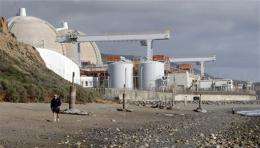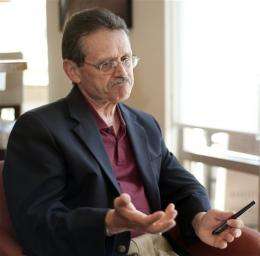A March 1, 2010 file photo, shows the San Onofre nuclear power plant in north San Diego County, Calif. Federal regulators say design flaws appear to be the cause of excessive wear in tubing that carries radioactive water through the San Onofre nuclear power plant. (AP Photo/Lenny Ignelzi, File)
(AP) — Federal regulators said Monday that a botched computer analysis resulted in design flaws that are largely to blame for unprecedented wear in steam tubes at the San Onofre nuclear power plant, but it isn't clear how the problems can be fixed.
The preliminary findings by a team of Nuclear Regulatory Commission investigators were disclosed nearly five months after the seaside plant was shut down following a break in a tube that carries radioactive water. There is no date to restart either of its two reactors.
The problems center on excessive tube wear in steam generators that were installed at San Onofre during a $670 million overhaul in 2009 and 2010. Tests found some tubes were so badly corroded that they could fail and possibly release radiation, a stunning finding inside the virtually new equipment.
Long unknown was what was causing tubes to vibrate and rub against each other inside the massive machines, manufactured by Mitsubishi Heavy Industries.
Greg Werner, who headed the federal team, said a Mitsubishi computer analysis vastly misjudged how water and steam would flow in the reactors. Also, changes intended to improve manufacturing were never thoroughly reviewed in the context of the generator design, resulting in weaker support around bundles of tubes that contributed to vibration, he said.
The plant's operator, Southern California Edison, could face penalties, while problems at the plant have raised fears of a nuclear accident in Southern California and cut off one of the region's important sources of power.
"The ultimate responsibly resides with them ... because they are responsible for safety," said Regional Administrator Elmo Collins, the agency's top official in the western U.S.
When the generators were designed, the crucial tool Mitsubishi used, a computer model, failed to predict conditions inside the machines and resulted in the tube shaking, Collins said.
Edison agreed with the findings.
In an interview with The Associated Press on Sunday, Collins said missteps in fabrication or installation were considered as possible sources of the rapid tube decay but "it looks primarily we are pointed toward the design" of the generators.
In this Sunday, June 17, 2012 photo, Elmo Collins, regional administrator of the Nuclear Regulatory Commission, speaks during an interview in San Juan Capistrano, Calif. The NRC is holding a public meeting to discuss the state of the San Onofre nuclear power plant on Monday in San Juan Capistrano. After months of investigation, federal regulators have determined that design flaws appear to be the cause of excessive wear in tubing that carries radioactive water through the power plant. (AP Photo/Grant Hindsley)
Collins didn't rule out that one or more of the generators might have to be replaced. "We think it's too early to tell," he told reporters.
The findings were released during a three-hour meeting Monday in which officials also faced sometimes-testy questions from local citizens concerned about safety.
Outside the hearing, protesters from Friends of the Earth and other groups critical of the nuclear industry displayed signs that said "Not another Fukushima" and "Shut unsafe San Onofre."
The group on Monday filed a petition asking the NRC to keep the plant offline until the company amends its license to reflect design changes in the generators.
"This is a safety problem," said Friends of the Earth consultant Arnie Gundersen, a former nuclear industry executive and licensed reactor operator who has written several reports on the San Onofre generators. "These changes put the public at risk."
So far, a fix has remained elusive.
"It's not too hard to frame up the problem," Collins told AP. "The answers are very difficult, or they already would have emerged."
The disclosure will rivet new attention on a series of alterations to the equipment design, including the decision to add 400 tubes to each generator and installing V-shaped supports that were intended to minimize tube wear and vibration. According to company documents, each of the replacement generators weighed nearly 24 tons more than the original generators.
The generators were designed to meet a federal test to qualify as "in-kind," or essentially identical, replacements for the original generators, which would allow them to be installed without prior approval from federal regulators.
The agency is reviewing how that was handled.
Inside the guts of the machinery, the original steam generators and the replacements "look substantially different," Collins said.
Company officials and Collins said safety would remain the first consideration at San Onofre. About 7.4 million Californians live within 50 miles of San Onofre, which can power 1.4 million homes.
"These are significant technical issues. They are not resolved yet," Collins said.
The company said in a statement that the Unit 2 reactor likely would remain offline at least through August, pending NRC approval for a restart. It did not project a restart date for Unit 3, where tube damage has been more severe. The company is expected to submit a plan to the NRC later this summer to restart one, or both, reactors, which would have to outline how the company can control the tube damage.
Copyright 2012 The Associated Press. All rights reserved. This material may not be published, broadcast, rewritten or redistributed.






















